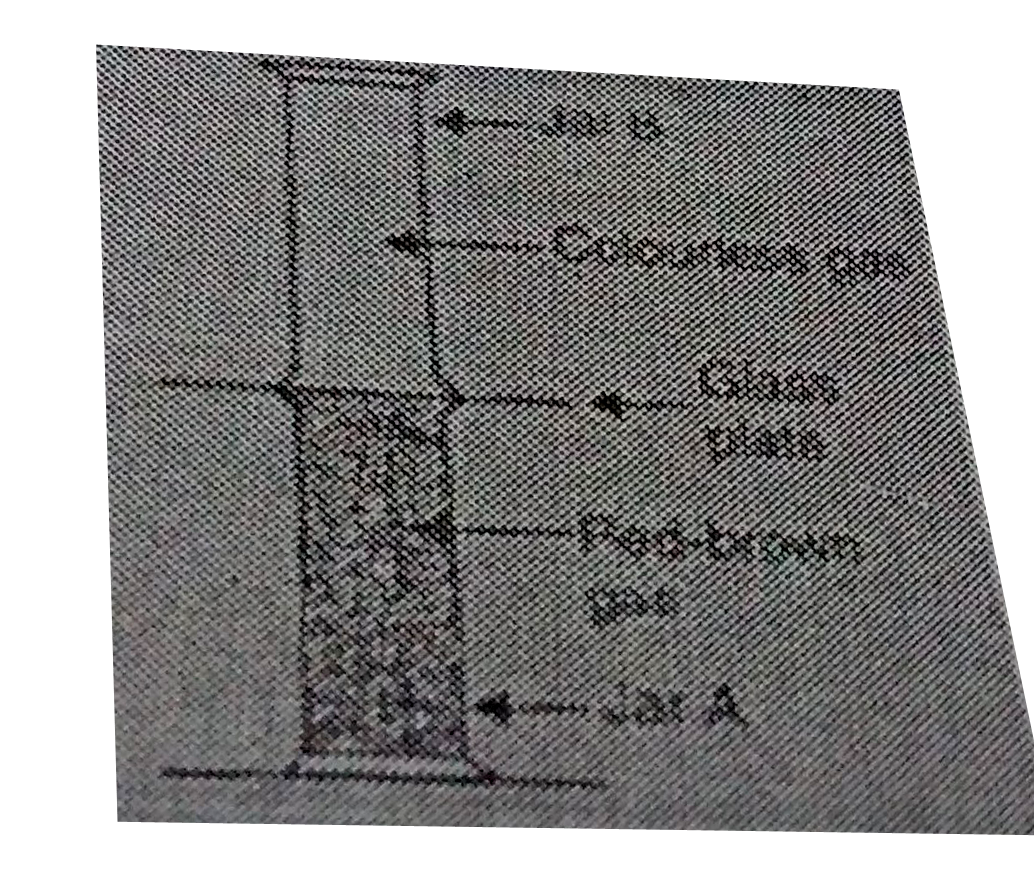The diagram shows the apparatus set-up for an experiment. Gas jar ( A) contains a brown gas, nitrogren dioxide and gas jar ( B) contains hydrogen > The molecular masses of nitrogen dioxide and hydrogen are 46 and 2 respectively.

Describe and explain the follwoing observations in the two gas jars as the experiment proceeds.
The amount of the gases in the gas jars.
The amount of the gases in the gas jar : Initiallymore hydrogen gas will diffuse into gas jar ( A) than nitrogen dioxide into gas jar ( B ). Eventually, nitrogen dioxide and hydrogen will completely mix. Thus, each gas jar will contain the same amount of nitrogen dioxide and hydrogen.
Topper's Solved these Questions
- FOOTSTEPS TOWARDS(CBSE BOARD)BOOK - MTG IIT JEE FOUNDATIONCHAPTER - FOOTSTEPS TOWARDS(CBSE BOARD)EXERCISE - SECTION-D
14 Videos
- FOOTSTEPS TOWARDS(CBSE BOARD)BOOK - MTG IIT JEE FOUNDATIONCHAPTER - FOOTSTEPS TOWARDS(CBSE BOARD)EXERCISE - SECTION-B
11 Videos
- FOOTSTEPS TOWARDS (NEET)BOOK - MTG IIT JEE FOUNDATIONCHAPTER - FOOTSTEPS TOWARDS (NEET)EXERCISE - QUESTIONS
44 Videos
- IS MATTER AROUND US PURE ?BOOK - MTG IIT JEE FOUNDATIONCHAPTER - IS MATTER AROUND US PURE ?EXERCISE - OLYMPIAD/ HOTS CORNER
20 Videos
Similar Questions
The diagram shows the apparatus set-up for an experiment. Gas jar ( A) contains a brown gas, nitrogren dioxide and gas jar ( B) contains hydrogen > The molecular masses of nitrogen dioxide and hydrogen are 46 and 2 respectively.

Describe and explain the follwoing observations in the two gas jars as the experiment proceeds.
The colour of the gas.
View SolutionThe diagram shows the apparatus set-up for an experiment. Gas jar ( A) contains a brown gas, nitrogren dioxide and gas jar ( B) contains hydrogen > The molecular masses of nitrogen dioxide and hydrogen are 46 and 2 respectively.

Describe and explain the follwoing observations in the two gas jars as the experiment proceeds.
The speed of the gas particles.
View Solution
Knowledge Check
When a burning magnesium ribbon is introduced in a gas jar containing oxygen, it will burn with :
Aa reddish flameBa pale blue flameCa golden yellow flameDa dazzling white flameEqual volumes of hydrogen and oxygen gasses of atomic weights 1 and 16 respectively are found to exert equal pressure on the walls of two separate containers the ratio of rms speed of hydrogen and oxygen gas is
A1:4B4:1C1:32D32:1Two separate bulbs contain ideal gas A and B. The density of gas A is twice that of B. The molecular mass of A is half that of B. The two gases are at the same temperature. The ratio of pressure A to that of gas B is :
A2B12C4D12
When a gas jar containing air is inverted over a gas jar containing bromine vapour, the red-brown bromine vapour diffuse into air. Explain how bromine vapour diffuse into air.
View SolutionLook at the diagram on the right side, jar A contains a red-brown gas whereas jar B contains a colourless gas. The two gas jars are separated by a glass plate placed between them

What will happen when the glass plate between the two jars is pulled away ?
What name is given to the phenomenon which takes place ?
Name the brown gas which could be in jar A.
(d) Which is the colourless gas most likely to be present in jar B ?
(e) Name one coloured solid and one colourless liquid which can show the same phenomenon
View SolutionTwo monoatomic ideal gases 1 and 2 of molecular masses m1 and m2 respectively are enclosed in separate containers kept at the same temperature. The ratio of the speed of sound in gas 1 to that in gas 2 is given by :-
View SolutionTwo monatomic ideal gases 1 and 2 of molecular masses m1 and m_(2)repectivelyareenclosed∈separateconta∈erskeptatthesametemprature.Theratiooftheofsound∈gas1→tˆ∈gas2 is given by
View SolutionConsider two sealed jars of equal volume. One contains 2 g of hydrogen at 200 K and the other contains 28 g of nitrogen at 400 K. The gases in the two jars will have -
View Solution
